Radio silence. One of the worst things that can happen while completing a website project.
Many project managers are familiar with this scenario. They complete a web development milestone, passing the baton to the client for feedback. Hours turn into days — sometimes weeks — without hearing back from the client.
And when they finally receive feedback, it involves vague instructions from clients (most with non-technical backgrounds) or hundreds of screenshots — then having to manage and assign them to multiple team members.
The stressful and time-consuming minutia of gathering, managing, and coordinating feedback can suck the life out of an exciting project like web design and development.
That's where client feedback tools come into play.
Client feedback tools are software applications that allow agencies to collect feedback. They address the challenges of delayed feedback, miscommunication, multi-stakeholder coordination, and tracking changes.
Client feedback tools can include on-page and real-time annotation, surveys, feedback forms, live chat support, and social media listening tools.
If you're looking for a client feedback tool, use this guide to decide which one's right for your business. Let's dive deep into what client feedback tools are — why your team needs them, key features to look for, and the top tools available in the market.
Understanding Client Feedback Tools
A client feedback tool is any software or platform that gathers, manages, and coordinates client feedback for the rest of the team. Typically a centralized platform, it's an important tool in a project manager's arsenal to streamline the feedback loop and align project outputs with client expectations.
Types of Client Feedback Tools
There are several tools for client feedback in the market today:
Feedback and Annotation: Clients can provide comments, annotations, or markups straight onto the project assets — whether design, content, prototype, or bugs. Typically on a centralized platform, these visual design feedback tools allow various team members to view comments on the same page in real-time, allowing alignment, clear communication, and contextual feedback.
Survey: Certain tools create customized surveys that allow structured feedback. Surveys can cover key insights on design preferences, user experience, and overall satisfaction.
Project Management: Several website project management tools are in the market today, but only a handful offer client feedback. Features like task assignments, progress tracking, commenting, and file attachments allow clients to provide feedback directly on assigned tasks.
Customer Feedback vs. Client Feedback
When looking for the right feedback tools, be clear on the intent and purpose you will use them for. Is it for getting feedback from the client or customers?
Customer feedback tools are designed to gather feedback from the general public — the end-users of your client's product or service. Tools like Typeform and Hotjar focus on improving customer satisfaction and use methods like heatmaps, clickmaps, A/B tests, surveys, reviews, sentiment analysis, and chatbot interactions.
Client feedback tools are specifically tailored for managing feedback from clients involved in a project. Tools like BugHerd facilitate communication and collaboration between project teams and clients. They gather feedback on project deliverables, design preferences, functionality requirements, and more.
The context of using client feedback tools is specific to projects where clients have a direct stake and influence over the outcome.
Importance of Collecting Client Feedback
Collecting client feedback ensures that your agency's outputs hit the right note for your intended audience. It can help your team build a stronger relationship with the client (not to mention a solid reputation) while impacting customer satisfaction and retention.
Identifying and Addressing Unsatisfied Customers: Not every customer will voice their concerns. But by actively seeking feedback, you can uncover the pain points and issues. Customer feedback can inform how your client can improve their offerings and customer experience strategies.
Minimizing Customer Churn: When customers feel that their opinions matter and see that you take action based on them, trust and loyalty are built. By addressing concerns and making improvements based on client feedback, you demonstrate your commitment to their satisfaction, ultimately reducing the likelihood of them turning to your competitors.
Continuous Improvement: Client feedback acts as a compass, guiding you towards areas of improvement and how to refine them. For agencies, they inform your strategies for presenting your clients to the public — whether through website design or branding. This iterative process allows you to deliver high-quality outputs and meet your clients' (often ever-evolving) expectations.
Building Trust-Based Partnership: For B2B services, collecting client feedback is critical to open dialogue and building a trust-based partnership. For instance, clear communication and a collaborative approach in web design and development can help your agency understand the client's brand, product functionality, and UX requirements. By actively involving your clients in the design process and valuing their input, you establish a rapport with them.
Painting a Solid Reputation For Your Agency: Establishing productive client relationships leads to ongoing projects, referrals, and word-of-mouth recommendations. You don't just get your clients to sing your praises. You also get to build a solid reputation for your agency operations.
Client feedback tools play a crucial role in coming up with data-driven insights. They quantify customer satisfaction by enabling you to collect and analyze customer feedback through metrics.
They aggregate data so you can identify trends and patterns. You can measure satisfaction levels and cull actionable insights that prioritize your clients' preferences and drive continuous improvement.
Key Features to Look for in a Client Feedback Tool
There's an abundance of client feedback tools available in the market today. So now the question is: Which is the right one for you? Here are some key things to look for in a client feedback tool.
Ease of Use
The client feedback tool should be intuitive and user-friendly enough to be used by everyone on your team, regardless of tech savviness. A tool that requires a steep learning curve is friction — it will deter clients from providing feedback.
Customization Options
Look into your agency's requirements and preferences when collecting and managing feedback. Choose a client feedback tool that provides tailored feedback forms, questions, and rating scales. Find one that allows you to customize by providing custom fields, for instance.
Integration Capabilities
Select a client feedback tool that seamlessly integrates with your existing systems and workflows. If you're already using a customer relationship management (CRM) like Hubspot or project management tools like Asana, find one that has seamless API integrations with these platforms.
Pricing
There are many free or low-cost website feedback tools available. But the real question is, do they have the features and capabilities you're looking for? Consider whether they're low-cost in the long-term or will spending more now benefit you over the next few years. Watch out for hidden fees like additional plugins. Remember, these tools are worthy investments that will help you improve customer experience, reduce churn, and drive growth.
Whether It Fits Your Agency
What's the size of your organization? What's the industry you operate in? What is the type of feedback you aim to collect? Some tools may specialize in specific industries or offer advanced features better suited for large enterprises. In contrast, others may cater to small businesses or focus on specific feedback channels, such as surveys or social media listening.
Most tools also offer free trial periods. Take advantage of them so you can assess if they meet your requirements.
Best Client Feedback Tools in 2026
BugHerd
Reviews: 4.8/5.0 (G2)
BugHerd is a client feedback tool with an intuitive interface, making contextual feedback on any webpage and bug detection a breeze. This has powerful features that can streamline your web design workflow — from real-time, on-page collaboration to task management.
Simply create an account and download the extension into your browser, and you're ready to go.
BugHerd is the perfect bug tracker tool for getting feedback from clients, especially those who don't have a technical background or can't articulate their comments in the context of web design and development. The tool allows them to tag a specific part of a web page that needs changes, leave a comment or annotation, tag the team member, and assign the severity level (minor to critical).
Managing and assigning feedback happens instantaneously as someone leaves a comment on the page. Users can assign the status (i.e., to-do, doing, done), and the tasks are organized in a Kanban board.
BugHerd fits right into your existing tech stack through integrations with Asana, Slack, Trello, Jira, Github, Zapier, WordPress, and many others.
Use BugHerd to ensure your client is happy with the web design work you're completing for them and to keep timelines from blowing out by getting last-minute change requests.
Clients using BugHerd say there's a minimal learning curve. The first time they used BugHerd, they figured out how to use it and go about the interface immediately.
Price starts at $42 a month. Try the 7-day free trial to determine if it fits your agency's workflow.
Try BugHerd today.
Zonka Feedback
Reviews: 4.6/5.0 (G2)
Zonka Feedback is an AI-powered Customer Feedback & Intelligence Platform that helps businesses collect, analyze, and act on customer feedback across multiple touchpoints. It supports NPS, CSAT, and CES surveys with omnichannel distribution via email, SMS, WhatsApp, web, in-app, and offline kiosks, making it suitable for both digital and physical customer journeys.
If you are looking for a scalable client feedback tool that goes beyond surveys, Zonka Feedback stands out with AI-driven sentiment analysis, theme detection, and automated workflows to close the feedback loop. Teams can manage responses in a centralized inbox, trigger alerts, and integrate feedback with tools like CRM and helpdesk systems to drive timely action and insights.
Pricing available on request.
Usersnap
Reviews: 4.5/5.0 (G2)
Usersnap allows users to provide feedback on satisfaction ratings with screen recordings, vocal feedback, and surveys.
If you need user feedback to determine product market fit or customer satisfaction, Usersnap is for you. It allows you to customize surveys to match your brand and reply to customers on their feedback. You can also use sentiment analysis and score-based follow-up questions to dive deeper into user insights.
Price starts at $69 a month (on a yearly plan), and you can try it for free for 15 days.
SatisMeter
Reviews: 4.8/5.0 (G2)
SatisMeter is a customer survey tool that allows you to collect and analyze user feedback, specifically on customer loyalty and calculating the Net Promoter Score (NPS).
This tool lets you roll out in-app and email surveys and set up automation workflows so you can stay on top of customer feedback.
SatisMeter has seamless integration with Slack, Mailchimp, and Salesforce.
You can try SatisMeter for free with 25 monthly responses (or around 250 active users). Pricing starts at $199 monthly.
CustomerSure
Reviews: 3.5/5.0 (G2)
CustomerSure is an enterprise-level tool that allows you to send surveys and calculate key metrics relating to customer satisfaction and effort, like Net Promoter Score (NPS), Customer Satisfaction Score (CSAT), and Customer Effort Score (CES).
Surveys rolled out from CustomerSure are web- and mobile-friendly, not to mention GDPR-compliant. The tool offers advanced data segmentation, text analysis, and automatic reports and notifications.
CustomerSure is more expensive than others on this list — pricing starts at $330 a month.
Qualtrics
Reviews: 4.4/5.0 (G2)
Qualtrics is an experience management software that allows you to collect customer feedback and engage in meaningful conversation through the website, app, email, and SMS.
It also has advanced AI technology that analyzes the feedback and uncovers patterns and trends — data-driven insights that can inform decision-making and predict customer behavior.
Like CustomerSure, Qualtrics is an enterprise-level platform that big brands like Coca-Cola, Spotify, Toyota, and Samsung use.
Pricing is unclear on their website, but you can ask for a free demo and contact customer support.
Hotjar
Reviews: 4.3/5.0 (G2)
Hotjar is a user behavior analytics software whose primary product offering includes heatmaps, user recordings, and feedback surveys.
Hotjar is easy to integrate into your tech stack, like Hubspot, Google Optimize, Slack, and 3,000+ more integrations via Zapier. It's also GDPR- and CCPA-compliant.
Its basic plan gives you access to powerful features like data filter and segmentation, analysis of recordings and heatmaps, user sentiment chart, new vs. returning, etc.
It has a Basic plan at $0 (up to 35 daily sessions), but more features are accessible starting at $32 a month with 100 daily sessions and up.
Qualaroo
Reviews: 4.4/5.0 (G2)
Qualaroo is a customer research and feedback software that collects and analyzes customer insights. You can target users based on criteria like identity, geographic location, and behavior.
The tool boasts a range of features like an easy survey builder, skip logic, multi-lingual support, and insight collection from various sources like websites, apps, and products.
It has an AI-based sentiment analysis engine powered by IBM Watson that analyzes feedback and provides deeper insights into customer preferences. It's also got advanced targeting options that trigger surveys based on user behavior.
The software integrates with various CRM, analytics, and email marketing tools like Salesforce, Zapier, Optimizely, Slack, Hubspot, and Google Analytics, among many others.
It has a 15-day free trial (no credit card required), and the paid plan starts at $69 monthly.
Bazaarvoice
Reviews: 4.3/5.0 (G2)
If you're looking for a tool that builds social proof on your website, then Bazaarvoice is a great option.
Bazaarvoice is a shopper engagement platform that empowers you to collect, display, and distribute user-generated content (UGC). This tool aggregates feedback, reviews, and testimonials straight from the customers. It also lets you showcase customer reviews on your product pages and share testimonials across various retail channels.
Pricing isn't published on their website, but they have plans under Essentials, Advanced, and Enterprise.
How to Choose the Right Client Feedback Tool for Your Business
Choosing the right client feedback tool is all about finding the one that aligns with your goals, budget, and overall business strategy. You must consider your agency's web design workflow, the nature of your projects, and the clients you deal with.
If you're working on web design projects, a tool allowing clients to provide live annotations on designs will make things easier for your designers and developers. Or, if you're managing multi-channel marketing campaigns, a feedback tool with robust integration capabilities could be your knight in shining armor.
What do you want to achieve with client feedback? Are you looking to understand customer satisfaction, gather ideas and suggestions for product improvement, or collect user experience data? Or are you looking into client collaboration and getting contextual feedback throughout the project cycle?
Once you have a clear goal in mind, it will be easier to narrow down your options.
The best tool doesn't necessarily have all the bells and whistles. It's one that seamlessly fits into your work process and makes life easier for your team and your clients.
Research and try a few free trials to find that perfect match. Going through the product first, you'll discover its features, usability, and whether it fits your team's workflow and tech familiarity. It's always worth the effort.


















But don't just take our word for it.
BugHerd is loved by 10,000+ companies,
350,000+ users across 172 countries.
4.8/5
4.7/5
4.5/5
5/5
8.7/10
Sam Duncan 📱📏 🌱
@SamWPaquet
"@bugherd where have you been all my life??
We just migrated our bug tracking over from Asana and have at least halved our software testing time🪳👏📈. "
Ashley Groenveld
Project Manager
“I use BugHerd all day every day. It has sped up our implementation tenfold.”
Sasha Shevelev
Webcoda Co-founder
"Before Bugherd, clients would try to send screenshots with scribbles we couldn't decipher or dozens of emails with issues we were often unable to recreate."
Mark B
Developer
“A no-brainer purchase for any agency or development team.”
Kate L
Director of Operations
"Vital tool for our digital marketing agency.”
Paul Tegall
Delivery Manager
"Loving BugHerd! It's making collecting feedback from non-tech users so much easier."
Daniel Billingham
Senior Product Designer
“The ideal feedback and collaboration tool that supports the needs of clients, designers, project managers, and developers.”
Chris S
CEO & Creative Director
“Our clients LOVE it”
Emily VonSydow
Web Development Director
“BugHerd probably saves us
at least 3-4hrs per week.”